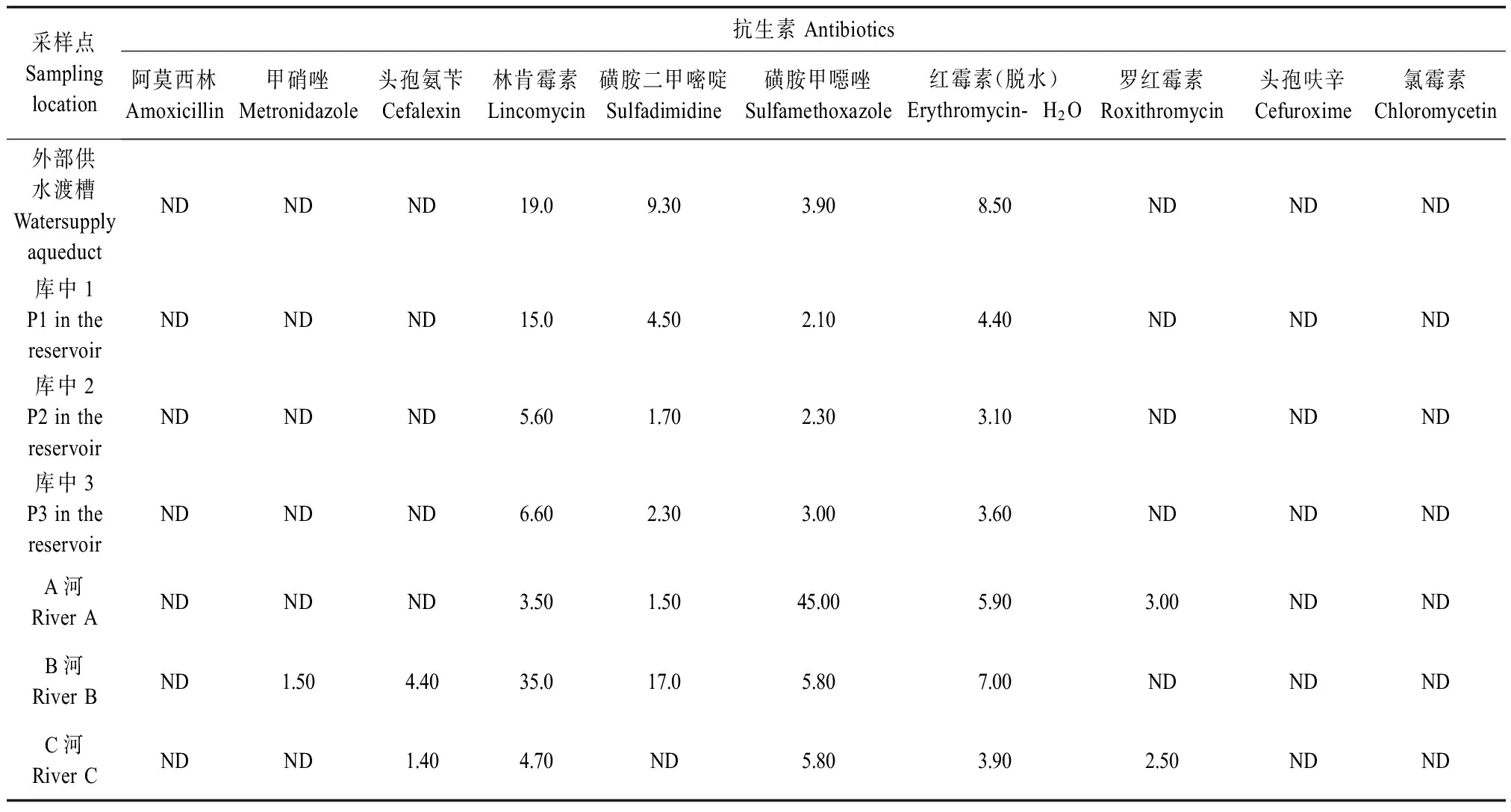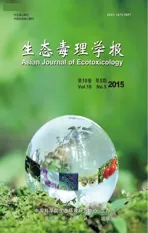南方某水库水体中抗生素生态与健康风险研究
2015-03-14朱婷婷宋战锋尹魁浩彭盛华
朱婷婷,宋战锋,尹魁浩,彭盛华
国家环境保护饮用水水源地管理技术重点实验室,深圳市饮用水水源地安全保障重点实验室,深圳市环境科学研究院,深圳 518001
南方某水库水体中抗生素生态与健康风险研究
朱婷婷*,宋战锋,尹魁浩,彭盛华
国家环境保护饮用水水源地管理技术重点实验室,深圳市饮用水水源地安全保障重点实验室,深圳市环境科学研究院,深圳 518001
环境中大量残留的抗生素将对生态环境和人体健康造成潜在危害。本研究采用风险商值法(RQ)评价了林肯霉素、红霉素(脱水)、罗红霉素、磺胺甲噁唑、磺胺二甲嘧啶、头孢呋辛、头孢氨苄、甲硝唑、阿莫西林和氯霉素10种抗生素对南方某水库水体产生的生态风险,并对10种抗生素进行了化学非致癌物风险评价。结果表明,7个采样点中共检出8种抗生素,残留量在1.2~130.0 ng·L-1之间。红霉素(脱水)、林肯霉素、磺胺甲噁唑这3种抗生素在丰水期、枯水期的所有采样点均有检出,磺胺二甲嘧啶和头孢呋辛在枯水期的检出率也为100%,而氯霉素和阿莫西林在7个样点均未检出。风险评价结果表明,除个别样点外,该水库抗生素残留的整体风险不高。丰水期和枯水期A河水体中磺胺甲噁唑的生态风险商大于1,A河(丰水期和枯水期)、B河(丰水期)和库中3号样点(枯水期)的联合毒性风险商大于1,表明这3个样点的抗生素残留对生态环境存在较严重的威胁,其余采样点抗生素的联合毒性风险商处于0.1到1之间,需长期观测其抗生素的环境动态,以避免高风险危害的发生。该水库10种抗生素残留引起的非致癌物风险数量级在10-15到10-12之间,说明该水库中10种抗生素通过饮水途径引起的非致癌风险很低,远低于可接受风险水平,甚至远低于可忽略风险水平。
抗生素;饮用水源水;生态风险;健康风险;水库
Received 15 July 2014 accepted 24 October 2014
抗生素是一类天然或者半人工合成的、能在低微浓度下有选择地抑制或影响它种生物功能的有机物质,人和动物使用的抗生素类药物无法完全被机体吸收,常常未经代谢便通过尿液和粪便以原药的形式排出体外,进入环境中[1]。近年来许多国家的河流、湖泊、地下水中均检出了抗生素残留,抗生素滥用所造成的环境污染问题逐渐成为研究者关注的焦点[2-5]。目前,欧美等发达国家已经就水环境中抗生素的残留水平和环境行为开展了较多研究,结果表明,水环境中微量水平的抗生素即会对生态环境和人体健康产生威胁[3,6-8]。目前国内的研究主要集中在抗生素检测方法的建立及对食品、水产品、污水处理厂进出水[9]、化妆品等基质中抗生素的污染调查[10],而抗生素在饮用水源地水体中的污染情况及生态、健康风险评估则鲜有报道。本研究对南方某主要饮用水源地型水库及其入库支流中β-内酰胺类、大环内酯类、磺胺类等6类共10种常见的典型抗生素的污染特征进行了调查,并对水库及支流中抗生素的生态风险和非致癌风险进行了评估,揭示水库中抗生素的污染现状和生态、健康风险水平,为后续抗生素污染防控工作提供数据支持和科学理论依据。
1 材料与方法(Materials and methods)
1.1 仪器与试剂
仪器:Agilent 1100型高效液相色谱仪(美国, Agilent);API 2000三重四级杆串联质谱仪(美国, AB Sciex);多通道固相萃取仪(美国, Waters);BridgeTMC18色谱柱(2.1 mm×50mm, 5μm, 美国,Waters);EYELAMG-2200氮吹浓缩仪(日本,Rikakikai),AllegraX-22R高速台式离心机(美国,BackmanCoulter),Q-POD型MILLI-Q超纯水仪(德国,Millipore)。
试剂:标准品甲硝唑(纯度为99.5%)、头孢呋辛钠(纯度为97.5%)均购自德国DrEhrenstorferGmbH公司,阿莫西林(纯度>99%)、红霉素(纯度>99%)、磺胺甲恶唑(纯度>99%)、磺胺二甲嘧啶(纯度为99%)均购自美国Sigma-Aldrich公司,罗红霉素(纯度≥95%)、林肯霉素盐酸盐(纯度≥95%)均购自瑞士Fluka公司,头孢氨苄(纯度为99.9%)、氯霉素(纯度为99.8%)均购自德国RiedeldeHa⊇n公司),磺胺甲恶唑-C13(纯度为99%),氯霉素-d5(纯度为98%)均购自美国CambridgeIsotopeLaboratory,Na2EDTA溶液(纯度为99.0%~101.0%)、NaN3溶液(纯度为99.5%)均购自美国Sigma-Aldrich公司,甲酸(纯度为99%~100%,美国VWRInternational)。甲醇为色谱纯,其他试剂为分析纯,试验用水为超纯水。
1.2 水样中抗生素的测定
分别于2012年9月(丰水期)和2013年1月(枯水期)进行采样。根据水库及其主要入库支流的环境与水文基本特征,本研究布设了7个采样点,包括水库库中3个点、主要入库支流3个点(A河、B河、C河),以及境外引水工程的供水渡槽。水样采集与保存程序符合国家标准(GB/T5750.2-2006)。所有水样在分析前均储存于4 ℃冰箱,在采集后一周内完成检测。
采用高效液相色谱-串联质谱(LC-MS-MS)法测定水样中抗生素的浓度,方法的检出限为0.40~0.70ng·L-1,回收率为81.90%~110.00%,RSD为1.80%~7.10%。
1.3 生态风险评价方法
水环境中残留药物的生态风险可以通过风险商值(RQ)来评价[11-12]。计算公式如下:
RQ= MEC / PNEC
(1)
PNEC= LC50/AF或EC50/AF
(2)
RQsum= ΣRQi
(3)
式中:MEC,环境实测浓度,即药物在水环境中的实测质量浓度,ng·L-1;PNEC,预测无效应浓度,是在现有认知下不会对环境中微生物或生态系统产生不利效应的最大药物浓度,ng·L-1;LC50为半致死浓度,EC50为半最大效应浓度,ng·L-1,LC50和EC50均由文献中取得,当存在多个值时,取最小值;AF为评价因子,取water framework directive的推荐值(1 000);RQsum:联合毒性风险商,无量纲;RQi:抗生素i的RQ值,无量纲。
仅仅对单一污染物进行生态风险评价来确定对水环境是否“安全”,这不符合复合污染的实际情况,需根据各残留药物的总风险商RQ评价其在水环境中的生态风险[13]。当0.01RQ<0.10,为低风险;0.10RQ<1.00,为中风险;RQ1.00,为高风险[11,14]。
水环境中抗生素一般不是单一存在,而是多种抗生素共同存在的。目前关于抗生素环境风险的研究多集中在单一药品效应研究,缺乏对药品联合效应的考察,少量研究表明,水环境中多种抗生素共存时,抗生素的环境危害作用会因共存而加强[23-24]。因此,本文采用简单叠加模型(式3)计算抗生素的联合毒性风险商[25]。
1.4 健康风险评价方法
采用USEPA推荐的化学非致癌物通过饮用水途径所致的人体年均健康危害风险计算模型,评估抗生素的非致癌物风险[26]。
(4)
Rign=(Dig/RfDig)×10-6/70
(5)
Dig=2.2Ci/70
(6)
式(4-6)中,Rign,非致癌物i经饮用水途径所致平均个人健康危害风险,a-1;Dig,非致癌i经饮用水途径的单位体重日均暴露剂量,μg·kg-1·d-1;RfDig,为非致癌污染i经饮水途径的参考剂量,μg·kg-1·d-1;70为人的平均寿命,a;Ci,非致癌物浓度,μg·L-1。
2 结果与讨论(Results and discussion)
2.1 水库水体中抗生素的浓度水平
由表2和表3可见,在水库及主要支流的水样中,无论枯水期、丰水期均检出了抗生素残留,浓度范围在1.20~130.00 ng·L-1,与珠江、深圳河、深圳湾的检测结果[27-28]相比,该水库的抗生素残留处于较低的水平。在丰水期,除了氯霉素、头孢呋辛与阿莫西林外,其余7种抗生素均有检出,浓度水平在1.40~45.00 ng·L-1范围内,其中库中残留的抗生素种类主要为红霉素(脱水)、磺胺甲噁唑、磺胺二甲嘧啶和林肯霉素,残留浓度均低于15.00 ng·L-1。外部供水与库中检测出的种类一致,浓度在3.90~8.50 ng·L-1之间。3条入库支流中,A河与B河水体中抗生素含量较高。枯水期水样中,除了氯霉素和阿莫西林外,其余8种抗生素均有检出,浓度水平在1.20~130.00 ng·L-1范围内。枯水期库中采样点的抗生素平均残留量为45.20 ng·L-1,高于丰水期(18.10 ng·L-1)。
林肯霉素、红霉素(脱水)和磺胺二甲嘧啶是检出率最高且浓度最高的3种抗生素,除了由于这几种药物的用量大外,还因为这几种抗生素稳定性较高、亲水性强,很容易通过排泄和雨水冲刷等方式进入环境。阿莫西林在所有样品中均未被检出,根本原因是阿莫西林极易发生水解,降解速率很快,因而自然水体中一般无阿莫西林残留[29-30]。在丰水期和枯水期都没有检出氯霉素,分析是因为我国近年来在畜牧业等行业已禁止使用氯霉素原料及产品,因此环境中氯霉素的残留很少[29]。水库水体中抗生素的污染状况随着季节不同而有所变化,枯水期各采样点的抗生素残留均比丰水期严重,主要原因是在枯水期,正属冬春季节,病毒活跃,疾病高发,抗生素使用种类更多、用量更大;同时,由于受地形的影响,几条入库支流都比较短小,属于雨源型河流,流量在枯丰其差异悬殊,枯水期降水少,河流流量小,自净能力弱,导致枯水期水体中抗生素的残留浓度明显高于丰水期。

表1 各目标抗生素的预测无效应浓度(PNECs)Table 1 The predicted no effect concentration (PNECs) of the selected antibiotics (ng·L-1)
水库的污染物主要来源于水库附近的几个自然社区,水源保护区内主要的污染源有生活源、私人加工厂、餐饮、大排档、养殖场、果场、鱼塘及疗养院等,主要入库支流为A河、B河与C河。3条入库支流的抗生素残留种类比水库库中更丰富,浓度普遍更高。一方面随着河流两岸地区经济的发展和人口的增长,大量生活污水、生产废水未经处理直接排入河道,污染河水水质,另一方面,由于这几条河流水量比较小,且自净能力较弱,所以污染物浓度相对较高。

表2 丰水期水库水体中抗生素的浓度水平Table 2 Concentration of antibiotics in the reservoir in wet season (ng·L-1)
注:ND为未检出。
Note: ND, not detected.

表3 枯水期水库水体中抗生素的浓度水平Table 3 Concentration of antibiotics in the reservoir in dry season (ng·L-1)
注:ND为未检出。
Note: ND, not detected.
2.2 水库水体中抗生素生态风险评价
生态风险商评价结果见图1和图2。可以看出,不同时期水库水体中甲硝唑、头孢氨苄、磺胺二甲嘧啶和头孢呋辛的生态风险商均低于0.01,无明显生态风险,A河的磺胺甲噁唑生态风险商大于1.00,对生态环境存在较高的危害性,其余采样点的林肯霉素、磺胺甲噁唑和红霉素生态风险商介于0.01和1之间,存在一定生态风险。
风险简单叠加模型计算结果显示,丰水期时,外部供水和库中的抗生素联合生态风险在0.32~0.84之间,3条支流中,C河的RQsum最低,为0.48,处于中风险水平,B河与A河的RQsum均大于1.00,抗生素对生态环境的危害较大。枯水期时,水库水体中抗生素联合毒性风险水平较高,库中3号样点和A河的RQsum大于1.00,其中A河中抗生素RQsum高达5.39,对生态环境可能会产生较严重的危害,其余样点的RQsum在0.10~1.00之间,对生态环境存在中风险。
2.3 水库水体中抗生素健康风险评价
由表4和表5可知,10种抗生素对人体的非致癌风险介于7.25×10-15~1.63×10-11范围内,10种抗生素的总健康风险介于1.59×10-13~1.63×10-11范围内。在所有采样点,林肯霉素和红霉素(脱水)是其中的主要健康风险因素,阿莫西林和氯霉素在丰水期和枯水期均不存在非致癌风险。各采样点中,丰水期B河的总非致癌风险最高,枯水期C河的总非致癌风险最高。
国内针对饮用水源地水体中抗生素残留的非致癌风险评价研究还未见报道,目前尚无国际机构制定饮用水源地抗生素健康风险水平的评判标准,与不同国际机构制定的饮用水源地水质健康风险水平阈值(见表6)相比,该水库中抗生素污染引起的非致癌风险远低于可接受风险水平,甚至远低于可忽略风险水平,说明该饮用水源水体中这些抗生素的残留不会对人体构成明显的非致癌性危害。

图1 丰水期水库各点位的抗生素生态风险商

图2 枯水期水库各点位的抗生素生态风险商

表4 丰水期水库各点位抗生素对人体的非致癌风险Table 4 Non-cancer risk of the selected antibiotics in the reservoir in the wet season (ng·L-1)

表5 枯水期水库各点位抗生素对人体的非致癌风险Table 5 Non-cancer risk of the selected antibiotics in the reservoir in the dry season (ng·L-1)

表6 不同国际机构制定的饮用水源地水质健康风险最大可接受风险水平和可忽略风险水平[26]Table 6 The maximum acceptable limit and ignorable limit of health risk of potable water source established by international institutions[26] (a-1)
根据国际辐射防护委员会(ICRP)、英国皇家学会(TRS)、瑞典环境保护局(TSEPA)、荷兰建设和环境部(VROM)规定的饮用水源地水质健康风险最大可接受风险水平和可忽略风险水平见表6。
综上所述,可知:
(1)南方某水库水体中共检出了8种抗生素,浓度范围在1.20~130.00 ng·L-1,处于较低的残留水平。红霉素(脱水)、林肯霉素、磺胺甲噁唑这3种抗生素在丰水期、枯水期的所有采样点均有检出,在枯水期磺胺二甲嘧啶和头孢呋辛的检出率也为100%,而阿莫西林和氯霉素在所有水样中均未检出。水库库中抗生素的残留种类和分布规律与外部供水水源一致,库中浓度略低于供水水源。3条入库支流的抗生素污染程度普遍高于库中,其中,A河的污染最严重。枯水期比丰水期残留的抗生素种类更多、残留浓度也更高。
(2)根据MEC/PNEC风险综合评价体系,A河丰水期和枯水期磺胺甲噁唑的RQ均大于1,对生态环境具有高风险,其他采样点的林肯霉素、磺胺甲噁唑、红霉素(脱水)的RQ处于0.01与1之间,具有一定的生态风险。风险简单叠加模型计算结果表明,丰水期A河与B河的联合毒性风险商大于1,枯水期库中3号样点和A河的联合毒性风险商大于1.00,对生态环境可能会产生较严重的危害,其余样点的联合毒性风险商在0.10和1之间,对生态环境存在中风险。
(3)各采样点抗生素污染引起的非致癌总风险数量级在10-15~10-11,都远远低于国际机构制定的最大可接受和最大可忽略风险水平,说明该水库水体中这些抗生素的残留不会对人体产生明显的非致癌性健康危害。
[1] Hartmann A, Aldera C, Koller T, et al. Identification of fluoroquinolone antibiotics as the main source of human genotoxicity in native hospital wastewater[J]. Environmental Toxicology and Chemistry, 1998, 17(3): 377-382
[2] Xu W H, Zhang G, Zou S C, et al. Determination of selected antibiotics in the Victoria Harbour and the Pearl River, South China using high performance liquid chromatography electrospray ionization tandem mass spectrometry[J]. Environmental Pollution, 2007, 145(3): 672-679[3] Kümmerer K. Antibiotics in the aquatic environment-A review[J]. Chemosphere, 2009, 75(4): 417- 434
[4] Homem V, Santos L. Degradation and removal methods of antibiotics from aqueous matrices-A review[J]. Journal of Environmental Management, 2011, 92(10): 2304-2347
[5] Benotti M J, Trenholm R A, Vanderford B J, et al. Pharmaceuticals and endocrine disrupting compounds in U.S. drinking water[J]. Environmental Science & Technology, 2009, 43(3): 597-603
[6] Watkinsona A J, Murbyc E J, Costanzo S D. Removal of antibiotics in conventional and advanced wastewater treatment: Implications for environmental discharge and wastewater recycling[J]. Water Research, 2007, 41(18): 4164-4176
[7] Gao P P, Mao D Q, Luo Y, et al. Occurrence of sulfonamide and tetracycline resistant bacteria and resistance genes in aquaculture environment[J]. Water Research, 2012, 46(7): 2355-2364
[8] Zhu Y G, Johnson T A, Su J Q, et al. Diverse and abundant antibiotic resistance genes in Chinese swine farms [J]. Proceedings of the National Academy of Sciences of the United States of America, 2013, 110(9): 3435-3440
[9] 陈涛, 李彦文, 莫测辉, 等. 广州污水厂磺胺和喹诺酮抗生素污染特征研究[J]. 环境科学与技术, 2010, 33(6): 144-147
Chen T, Li Y W, Mo C H, et al. Screening of sulfonamide and fluroquinolone antibiotics in wastewater of sewage treatment plants in Guangzhou, South China [J]. Environmental Science & Technology, 2010, 33(6): 144-147 (in Chinese)
[10] 张桂香, 刘希涛, 赵烨, 等. 环境样品中抗生素残留分析研究进展[J]. 环境污染与防治, 2009, 31(10): 64-75
Zhang G X, Liu X T, Zhao Y, et al. Research advances on analysis of antibiotic residues in the environmental samples[J]. Environmental Pollution and Control, 2009, 31(10): 64-75 (in Chinese)
[11] EC (European Commission). European Commission Technical Guidance Document in Support of Commission Directive 93//67/EEC on Risk Assessment for New Notified Substances and Commission Regulation (EC) no.1488/94 on Risk Assessment for Existing Substance, Part II[R]. Brussels: EC (European Commission), 2003: 100-103
[12] Vryzas Z, Alexoudis C, Vassiliou G, et al. Determination and aquatic risk assessment of pesticide residues in riparian drainage canals in northeastern Greece[J]. Ecotoxicity and Environmental Safety, 2011, 74(2): 174-181
[13] 雷昌文, 曹莹, 周腾耀, 等. 太湖水体中5种有机磷农药混合物生态风险评价[J]. 生态毒理学报, 2013, 8(6): 933-940
Lei C W, Cao Y, Zhou T Y, et al. Ecological risk assessment of five organophosphorus pesticides mixture in Taihu Lake[J]. Asian Journal of Ecotoxicology, 2013, 8(6): 933-940 (in Chinese)
[14] Hernando M D, Mezcua M, Fernandez-Alba A R, et al. Environmental risk assessment of pharmaceutical residues in wastewater effluents, surface waters and sediments[J]. Talanta, 2006, 69(2): 334-342
[15] Stuer-Lauridsen F, Birkved M, Hansen L P. Environmental risk assessment of human pharmaceuticals in Denmark after normal therapeutic use[J]. Chemosphere, 2000, 40(7): 783-793
[16] Turkdogan F I, Yetilmezsoy K. Appraisal of potential environmental risks associated with human antibiotic consumption in Turkey [J]. Journal of Hazardous Materials, 2009, 166(1): 297-308
[17] Ågerstrand M, Rudén C. Evaluation of the accuracy and consistency of the Swedish Environmental Classification and Information System for pharmaceuticals [J]. Science of the Total Environment, 2010, 408(11): 2327-2339
[18] Ginebreda A, Muoz I, Alda M L. Environmental risk assessment of pharmaceutical substances in rivers:Relationships between hazard indexes and aquatic macroinvertebrate diversity Indexes in the Llobregat River (NE Spain)[J]. Environmental International, 2010, 36(2): 153-162
[19] Lin A Y C, Yu T H, Lin C F. Pharmaceutical contamination in residential, industrial, and agricultural waste streams: Risk to aqueous environments in Taiwan [J]. Chemosphere, 2008, 74(1): 131-141
[21] Park S, Choi K. Hazard assessment of commonly used agricultural antibiotics on aquatic ecosystems [J]. Ecotoxicology, 2008, 17(6): 526-538
[22] Isidori M, Lavorgna M, Nardelli A. Toxic and genotoxic evaluation of six antibiotics on nontarget organisms [J]. Science of the Total Environment, 2005, 346(1-3): 87-98
[23] Cleuvers M. Mixture toxicity of the anti-inflammatory drugs diclofenac, ibuprofen, naproxen and acetylsalicylic acid [J]. Ecotoxicology and Environmental Safety, 2004, 59(3): 309-315
[24] Cleuvers M. Aquatic ecotoxicity of pharmaceuticals including the assessment of combination effects [J]. Toxicology Letters, 2003, 142(3): 185-194
[25] Quinn B, Gagne F, Blaise C. An investigation into the acute and chronic toxicity of eleven pharmaceuticals (and their solvents) found in wastewater effluent on the cnidarian, Hydra attenuate [J]. Science of the Total Environment, 2008, 389(2-3): 306-314
[26] 王静, 刘铮铮, 许行义, 等. 浙江省饮用水源有机毒物污染特征及健康风险研究[J]. 环境污染与防治, 2010, 32(7): 29-33
Wang J, Liu Z Z, Xu X Y, et al. Study on pollution pattern and health risk of organic toxicants in Zhejiang source water [J].Environmental Pollution and Control, 2010, 32(7): 29-33 (in Chinese)
[27] 叶计朋, 邹世春, 张干, 等. 典型抗生素类药物在珠江三角洲水体中的污染特征[J]. 生态环境, 2007, 16(2): 384-388Ye J P, Zou S C, Zhang G, et al. Characteristics of selected antibiotics in the aquatic environment of the Pearl River Delta, South China [J]. Ecology and Environment, 2007, 16(2): 384-388 (in Chinese)
[28] 梁惜梅,施震,黄小平. 珠江口典型水产养殖区抗生素的污染特征[J]. 生态环境学报, 2013, 22(2): 304-310
Liang X M, Shi Z, Huang X P. Occurrence of antibiotics in typical aquaculture of the Pearl River Estuary[J]. Ecology and Environmental Sciences, 2013, 22(2): 304-310 (in Chinese)
[29] 朱婷婷,宋战锋,段标标,等. 深圳石岩水库抗生素污染特征与健康风险初步评价 [J]. 环境与健康杂志, 2013, 30(11): 107-110
Zhu T T, Song Z F, Yin K H, et al. Research on pollution and health risk by antibiotics in source water of Shiyan Reservoir in Shenzhen[J]. Journal of Environment and Health, 2013, 30(11): 107-110 (in Chinese)
[30] Mutiyar P K, Mittal A K. Occurrences and fate of an antibiotic amoxicillin in extended aeration-based sewage treatment plant in Delhi, India: A case study of emerging pollutant [J]. Desali-Nation and Water Treatment, 2013, 51(31-33): 6158-6164
◆
Assessments of Ecological and Health Risk Induced by Antibiotics in Source Water of a Reservoir in a Southern City
Zhu Tingting*, Song Zhanfeng, Yin Kuihao, Peng Shenghua
State Environmental Protection Key Laboratory of Drinking Water Source Management and Technology, Shenzhen Key Laboratory of Drinking Water Source Safety Control, Shenzhen Academy of Environmental Sciences, Shenzhen 518001, China
A large amount of environmental residues of antibiotics cause hazards and risks to the ecological environment and human health. In this paper, the ecological and health risk assessments were performed to evaluate the risk of 10 kinds of antibiotics, including lincomycin, erythromycin-H2O, roxithromycin, sulfamethoxazole, sulfadimidine, cefuroxime, cefalexin, metronidazole, amoxicillin and chloromycetin, in a reservoir in a southern city, China. Results showed that 8 kinds of antibiotic were detected in 7 sampling points, with the concentrations ranged from 1.2 to 130 ng·L-1. The detection frequency of erythromycin-H2O, lincomycin, sulfamethoxazole reached 100% both in high flow period and low flow period, while sulfadimidine and cefuroxime could only be detected in low flow period. However, chloromycetin and amoxicillin could not be detected in the selected 7 sampling points. Further risk assessment results showed that the overall risk was not high except some points. The risk quotients exceeded 1 for the sulfamethoxazole in River A (both high flow and low flow periods). Among sampling points, the combined risk quotients of all 10 antibiotics in River A (both high flow and low flow periods), River B (high flow period) and point 3 in the reservoir (low flow period) were higher than 1. It indicated that the residuals of antibiotics had high ecological risk in these stations. The risk quotients of other stations ranged from 0.10 to 1.00, illustrating that the long-term observations for antibiotics residuals in water are necessary. The sum of non-carcinogenic risks for the 10 antibiotics was in range of 10-15to 10-12, suggesting the acceptable health risks associated with antibiotics in the source water of the reservoir.
antibiotic; source water; ecological risk; health risk; reservoir
深圳市环境科研项目(SZCG2012033773);深圳市知识创新计划(JCYJ20120618154913166)
朱婷婷(1983-), 女, 博士, 研究方向为饮用水源保护研究, E-mail: xiaozhu.tt@163.com;
10.7524/AJE.1673-5897.20140715003
2014-07-15录用日期:2014-10-24
1673-5897(2015)5-124-08
X171.5
A
朱婷婷, 宋战锋, 尹魁浩, 等. 南方某水库水体中抗生素生态与健康风险研究[J]. 生态毒理学报,2015, 10(5): 124-131
Zhu T T, Song Z F, Yin K H, et al. Assessments of ecological and health risk induced by antibiotics in source water of a reservoir in a Southern City [J]. Asian Journal of Ecotoxicology, 2015, 10(5): 124-131(in Chinese)
